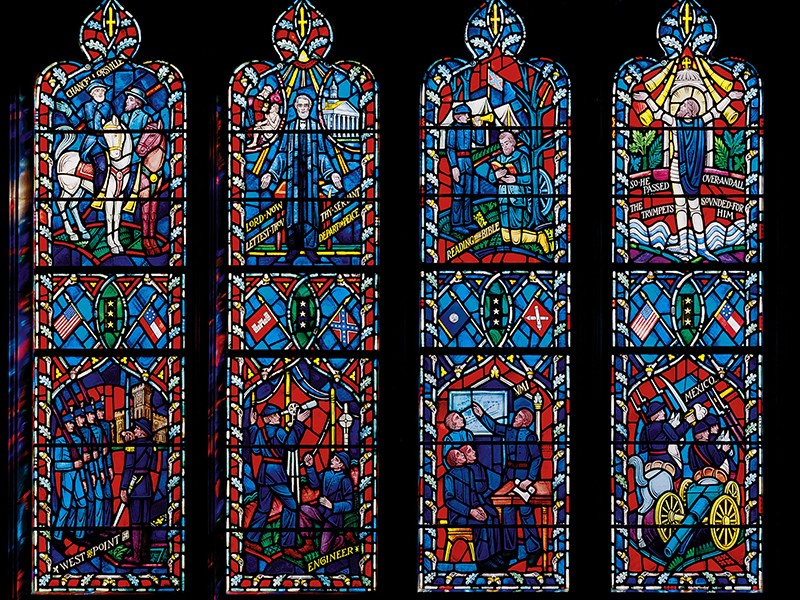Mainline churches in North and South wrestle with Confederate legacy
After Charlottesville, Christians are re-examining memorials to General Robert E. Lee and others.

The Washington National Cathedral has deconsecrated stained-glass windows honoring Confederate generals Robert E. Lee and Thomas “Stonewall” Jackson and made plans to remove the windows.
Other prominent houses of worship have also considered what to do with their Confederate memorials since a mid-August white supremacist protest in Charlottesville, Virginia. The white nationalists and neo-Nazis had gathered with the stated goal of opposing the city council’s decision to remove a statue of Lee from a city park, which a lawsuit put on hold for several months.
After the violence in Charlottesville, Duke University removed a statue of Lee from its chapel entrance. Members of R. E. Lee Memorial Episcopal Church in Lexington, Virginia, had previously considered whether to change its name but reaffirmed its decision against such a move at an August 21 meeting.
Read our latest issue or browse back issues.
The cathedral, the seat of the Episcopal Diocese of Washington, D.C., had planned to spend a lengthy period discussing race-related issues before deciding what to do with the windows. That plan was made after the fatal shooting of nine members of a Bible study at Emanuel African Methodist Episcopal Church in Charleston, South Carolina, in 2015.
A statement released September 6 said that the cathedral’s board, or chapter, voted to remove the windows sooner. The deconsecration service took place later that day.
“The Chapter believes that these windows are not only inconsistent with our current mission to serve as a house of prayer for all people, but also a barrier to our important work on racial justice and racial reconciliation,” reads a letter from Mariann Edgar Budde, Washington Episcopal bishop; Randy Hollerith; cathedral dean, and John Donoghue, Cathedral Chapter chair.
In August 2016, the cathedral quietly removed the panels depicting the Confederate flag and replaced them with red and blue panes to match surrounding glass. But the overall glass and stone bays honoring two generals, Robert Lee and Thomas “Stonewall” Jackson, remained.
The side-by-side windows honoring the Confederate generals were added in 1953 with the support of the United Daughters of the Confederacy, a group that sought to honor the memory of veterans who fought for the South.
Christ Church Cathedral in Cincinnati, Ohio, has a stained-glass window honoring Lee and a plaque dedicated to Leonidas Polk, an Episcopal bishop and Confederate general. Gail Greenwell, cathedral dean, has called for removing them.
In New York City, an Episcopal church where Lee once worshiped and served on the vestry removed two plaques honoring the general in August. Community members, including other local pastors, had expressed concern.
The plaques needed to come down “in support and solidarity of those who are victims of hate and racism in this country,” said Khader El-Yateem, founder of Salam Arabic Lutheran Church.
At Sewanee: The University of the South, a school with Episcopal roots and Confederate connections, administrators say the school has been engaged in an ongoing discussion of Confederate symbols on campus, where a monument to a Confederate general still stands.
St. Paul’s Episcopal Church in Richmond, Virginia, once known as “Cathedral of the Confederacy”—Jefferson Davis, president of the Confederacy, was a member—began reconsidering the Confederate symbols in its sanctuary after the 2015 massacre at Emanuel AME. The congregation developed the History and Reconciliation Initiative and decided to remove all battle flags but keep family memorials to fallen Confederate soldiers. Plaques still mark the pews where Lee and Davis once sat, and the pair are featured in stained-glass windows.
At R. E. Lee Memorial Church, which has been under pressure to change its name, leaders approved a statement condemning racism, anti-Semitism, and white supremacy, while defending Lee.
“We do not honor Lee as a Confederate,” the church vestry wrote. “We honor Lee as one of our own parishioners, a devout man who led our parish through difficult years in post-Civil War Virginia. . . . the best hope for Lee is the gospel of grace, through which we are all forgiven sinners. Our commitment is not to Lee, but to that gospel.”
Robert W. Lee IV, the general’s great-great-great-great-nephew, resigned September 4 from his position as a pastor amid controversy over his speaking out in favor of removing confederate monuments and against white supremacy.
MTV invited him to speak at its Video Music Awards on August 27, standing beside Susan Bro, the mother of Heather Heyer, the counterprotester who was killed in Charlottesville. He called Heyer an inspiration, along with the Black Lives Matter movement.
The appearance on MTV increased media attention on Lee and Bethany United Church of Christ in Winston-Salem, North Carolina, the congregation that hired him soon before he graduated from Duke Divinity School in May. While Lee said the church reacted in "deeply hurtful” way, some congregational leaders told local news that they were surprised by Lee’s resignation and were not aware of a conflict over his comments.
“We have made my ancestor an idol of white supremacy, racism, and hate,” Lee said at the awards show, according to a public statement released by Auburn Seminary. “As a pastor, it is my moral duty to speak out against racism, America’s original sin.”
A version of this article appears in the print edition with the title "Mainline churches in North and South wrestle with Confederate legacy."





